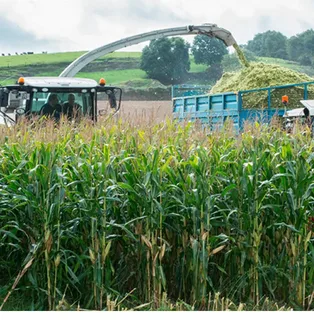-
أخر الأخبار
- استكشف
-
المدونات
-
المجموعات
Corn Silage Market analysis focuses on pricing dynamics and production efficiency in farming

Introduction
The Corn Silage Market is increasingly shaped by pricing dynamics and efficiency in production. As global demand for animal feed rises, farmers, producers, and suppliers are closely monitoring input costs, operational efficiencies, and market pricing structures to ensure profitability and sustainability.
Importance of Cost and Efficiency in Corn Silage Production
Corn silage is an integral part of the livestock feed ecosystem. It offers high energy, digestibility, and year-round availability. However, the cost-effectiveness of corn silage depends on:
-
Seed prices and fertilizer inputs
-
Labor and mechanization costs
-
Storage infrastructure
-
Moisture management
-
Market pricing and local demand
Understanding how pricing and production efficiency interact is essential for stakeholders who want to stay competitive and maximize returns in the evolving Corn Silage Market.
Key Pricing Factors in the Corn Silage Market
1. Cost of Raw Materials
The cost of producing corn silage starts with seed, fertilizer, pesticide, and fuel. Price volatility in any of these inputs directly affects silage costs. For example:
-
Droughts or floods can cause fertilizer shortages, raising prices
-
Global oil prices affect diesel costs for tractors and harvesters
-
Hybrid seeds may be more expensive but offer higher yield per hectare
Farmers must balance these inputs to avoid overexpenditure while maintaining feed quality.
2. Labor and Equipment Costs
Mechanization significantly boosts efficiency but comes with upfront costs. Key considerations include:
-
Cost of forage harvesters, silage wagons, and loaders
-
Maintenance and fuel expenses
-
Wages for skilled labor to operate machinery and manage fermentation
Some regions mitigate high labor costs with custom silage-making contractors or cooperative machinery pools.
3. Storage and Preservation Expenses
Effective silage storage prevents spoilage and nutrient loss. Investment in silage bags, silos, or bunkers adds to total production costs. The choice between low-cost pit storage and high-tech sealed systems depends on:
-
Farm size
-
Climate conditions
-
Access to capital
Poor storage results in wastage, directly increasing cost per usable ton.
4. Regional Market Prices and Demand
Corn silage prices vary regionally based on local feed demand and supply chains. Key influences include:
-
Density of dairy and cattle farms
-
Competing feed sources (e.g., hay, grains)
-
Transportation availability and fuel prices
-
Seasonal surpluses or shortages
In high-demand areas, silage fetches premium prices, whereas remote or oversupplied regions see lower rates.
Strategies to Improve Production Efficiency
Efficiency in silage production involves maximizing output and quality while minimizing inputs and losses. Effective strategies include:
1. Use of High-Yielding Hybrids
Modern corn hybrids offer higher tonnage per acre and better digestibility. They mature uniformly, facilitating consistent harvesting and fermentation. This improves:
-
Dry matter yield
-
Energy content
-
Feed conversion rates
Though hybrids cost more initially, their return on investment through higher yields is substantial.
2. Timely Harvesting and Moisture Management
Harvesting corn at the optimal stage (30-35% dry matter) improves silage quality and prevents fermentation failures. Farmers use moisture sensors and crop scouting to optimize timing.
3. Improved Compaction and Sealing
Proper compaction eliminates oxygen, a key factor in preventing spoilage. Sealing the silage well reduces dry matter loss. Techniques include:
-
Using weighted plastic covers or vacuum sealing
-
Layering silage evenly in bunkers
-
Monitoring temperature during early fermentation
Efficient storage ensures better quality feed and minimizes nutrient loss.
4. Custom Hiring and Equipment Sharing
For small and medium-sized farms, sharing harvesting equipment or hiring silage-making contractors helps reduce capital and operational expenses. This model is common in Asia and Africa.
5. Use of Silage Inoculants
Inoculants improve fermentation speed and quality, reducing spoilage risk and extending silage shelf life. Though a small cost, they significantly boost efficiency and nutritional value.
Global Variations in Silage Pricing
North America
Corn silage pricing here is highly influenced by fuel and labor costs. However, large-scale operations benefit from economies of scale and better access to equipment financing.
Europe
European farms focus on quality-certified silage. Price is higher due to sustainability compliance, but government subsidies balance costs and promote efficient practices.
Asia-Pacific
In India and China, low-cost silage production methods dominate, but price variations are driven by monsoon dependency and logistics. Smallholders often buy from centralized silage producers at negotiated rates.
Latin America
With large arable land and export-oriented livestock operations, Brazil and Argentina maintain relatively stable silage prices. Innovations in logistics and on-farm production increase efficiency.
Africa
Silage pricing in Africa is influenced by feed scarcity and lack of storage infrastructure. Donor-driven models and cooperatives help stabilize prices through shared production.
Economic Benefits of Efficient Silage Production
Producers who optimize costs and processes enjoy several advantages:
-
Higher profits due to reduced feed cost per animal
-
Consistent animal performance, lowering veterinary expenses
-
Flexibility to scale operations with predictable feed supply
-
Lower carbon footprint through reduced waste and efficient land use
Such benefits are critical in maintaining competitiveness, especially in export-driven dairy and meat industries.
Challenges to Pricing and Efficiency
Despite growth, several challenges persist:
-
Unpredictable climate affects yield and harvest schedules
-
Smallholders lack access to financing for mechanization
-
Regional transportation limitations inflate feed prices
-
Knowledge gaps result in inefficient silage production
Targeted interventions—like training programs, government subsidies, and digital advisory tools—are helping mitigate these barriers.
Conclusion
Pricing dynamics and production efficiency are central to the evolution of the Corn Silage Market. With rising demand for cost-effective and high-quality livestock feed, producers must focus on optimizing their input-output ratios and improving silage storage, harvesting, and preservation. As farms become more data-driven and connected, silage production will continue to evolve into a more profitable and sustainable endeavor for agricultural communities across the globe.






